Review: Big Agnes Insulated AXL Pad || Very light & comfy, not very warm
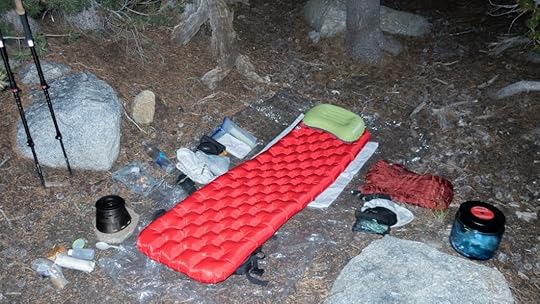
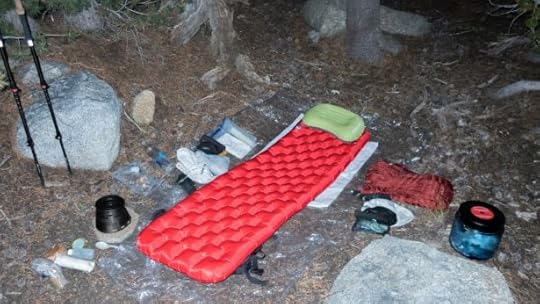
My cowboy camp in upper Conness Creek on the Yosemite High Route in August. (My quilt was air-drying in a nearby bush.) Nighttime temps were normally in the high-30’s/low-40’s, and I found the Insulated AXL to be sufficiently warm.
Until last spring, Big Agnes had no sleeping pads in its line that interested me. The pads looked comfortable, but they were considerably heavier than my time-tested Therm-A-Rest NeoAir XLite ($170, 12 oz).
But with the AXL sleeping pad, Big Agnes caught my attention — its weight and thickness looked promising. The AXL comes in two flavors:
AXL Air ($140, 9.6 oz), for mild temperatures; and,
Insulated AXL Air ($180, 10.6 oz), for 3-season conditions.
The listed prices and weights above are for the 20″ x 72″ mummy version. Both pads are also available in rectangular shapes: a wide AXL (25 x 72); and petite, regular, regular-wide, and long-wide Insulated AXL (20 x 66, 20 x 72, 25 x 72, and 25 x 78).
This year I have slept on the Insulated AXL (as a normal ground pad and as under-insulation in a hammock) for about 30 nights in southern Utah, the Colorado Rockies, and High Sierra. Big Agnes sent me two pads, and I loaned out the other to my wife and to guided clients for additional feedback.
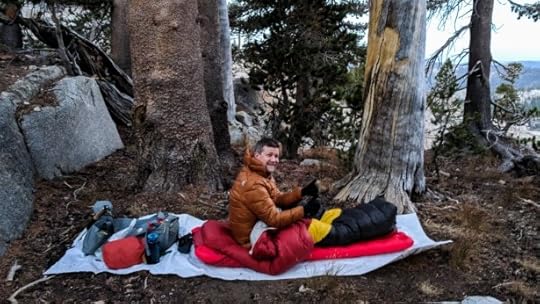
Two thumbs up, Paul reports after a night on the Insulated AXL in Sequoia-Kings Canyon National Park in late-September, which is about its seasonal limit in the Mountain West.
Review: Big Agnes Insulated AXL Sleeping Pad
The Big Agnes Insulated AXL Air is a very lightweight and comfortable sleeping pad, and is best suited for weight-conscious backpackers who want quality sleep in the backcountry.
The 20″ x 72″ rectangular Insulated AXL specs at just 11.9 oz (although mine weighs 12.6 oz, or 12.9 oz with the included stuff sack). In its factory packaging, it’s about the size of a 1-liter bottle — although, it’s difficult (and not worth the time, IMO) to pack it that tightly again. I roll mine full-width, fold it in half, and keep it in a larger stuff sack.
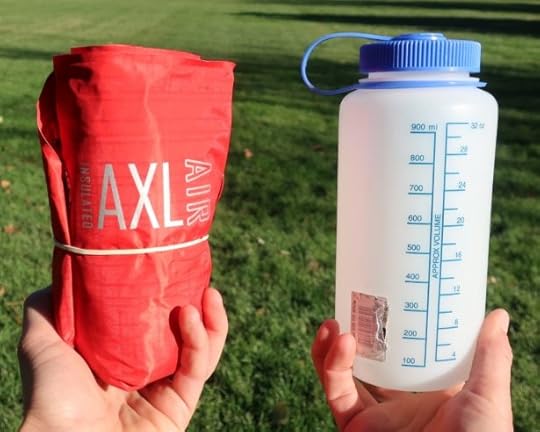
When rolled tightly, the Insulated AXL is about he size of a 1-liter bottle.
Of the pads that compete with the Insulated AXL’s size and weight, none match its thickness (3.25 to 3.75 inches) or have over-sized outer tubes that help to cradle the sleeper — it’s a subtle feature, but helpful.
The Insulated AXL is reasonably quiet, avoiding the “potato chip bag” sensation of other leading pads. On my first trip out with it, on which I also used a new tent, it produced a sound similar to rubbing balloons together. But I have not noticed it since, leading me to think that it was the new pad, the new tent floor, or the combination of the two materials.
The Insulated AXL is appropriate for 3-season conditions, but not for shoulder seasons and definitely not for winter. Personally, I found the Insulated AXL to be amply warm in temperatures of 40+ (4+ C) and to be acceptable in temperatures of 30+ (0+ C) so long as I took other measures to maximize my nighttime warmth (e.g. bring a warm sleeping bag, pick a soft campsite, sleep in my insulated clothing, and eat and hydrate well before bed).
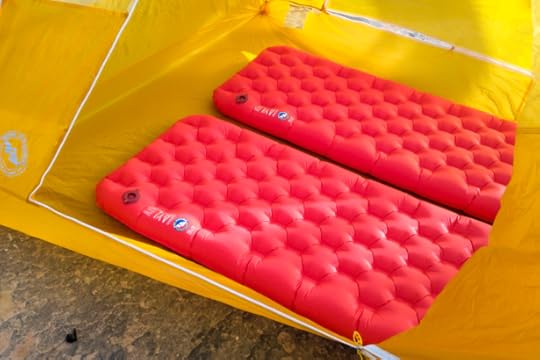
His and her pads inside a Big Agnes Tiger Wall 3. The Insulated AXL is normally quiet, but not on this trip in southern Utah — it sounded like two balloons being rubbed together. I’m uncertain the cause: new pads, a new tent, or a combination of the two.
Key specs
Rated to 32 degrees
3.75-inch thick outer tubes, 3.25-inch inner
20d high-tenacity rip-stop nylon top and bottom shell
Primaloft Silver synthetic insulation laminated to a Mylar sheet
Five SKU’s, varying with shape, length, and width
10.6 to 15.9 oz, depending on the size
$160 to $250, depending on the size
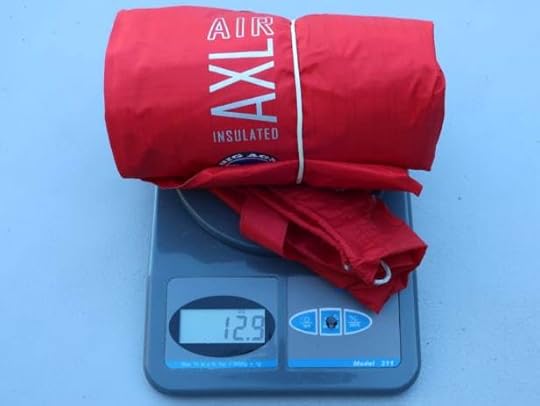
My 20 x 72 Insulated AXL came in at 12.6 oz (+0.3 oz for the stuff sack), over its spec weight by 0.7 oz.
The competition
For those who prioritize pack weight and volume, the Insulated AXL is one of two 3-season pads that I can personally recommend, along with the aforementioned XLite.
On paper, other contenders include the:
Exped SynMat UL ($170, 13 oz), which is the most comparable to the AXL and XLite, and which is reportedly comfortable, warm, and quiet;
Klymit Insulated Static V Ultralight SL ($120, 16 oz), which is a few ounces heavier but a good value;
NEMO Tensor Insulated Ultralight ($160, 15 oz), which has been updated for 2019, possibly causing closeouts of the current model; and,
Sea-to-Summit Insulated Ultralight ($140, 17 oz), which is heavy but has proven reliable.
Big Agnes Insulated AXL vs Therm-A-Rest NeoAir XLite
The Insulated AXL is more comfortable than the XLite. It’s thicker and has oversized outside tubes, and it’s quieter.
But the XLite is warmer. I do not hesitate in using the XLite on elk hunting trips in the Colorado Rockies in November, or even on winter trips when I must sleep on snow. I would not use the Insulated AXL beyond 3-season conditions.
If your backpacking season extends into colder months, the XLite may cover you completely. Whereas if you were to purchase the Insulated AXL, you’d need an additional cold-weather pad.
Warmth
When the Insulated AXL was first released, Big Agnes recommended a usable range of 15 to 35 degrees F (-9 to 2 C) on its website and product packaging. Based on my experience I believe these guidelines were generous, and unfortunately REI — which was the exclusive distributor of the AXL and Insulated AXL when it was first released — hyped expectations even more by advertising it simply as a 15-degree pad.
Customers were not pleased, and revenged their sleepless nights by giving the Insulated AXL many 1-star reviews.
Per the manufacturer website, currently the Insulated AXL is “rated to 32 degrees.” There is no discussion of how Big Agnes arrived at this number, or exactly what it means — i.e. Is 32 degrees a comfort limit, or a lower bound? And under what conditions (e.g. sleeping bag temperature rating, shelter type, ground surface composition) would this rating apply?
What is the R-value of the Insulated AXL?
Big Agnes does not publish (and, from what I can tell, does not test in-house) R-values, which is a precise measure of a pad’s resistance to conductive heat transfer. These values are useful in comparing the absolute and relative warmth of a sleeping pad.
Why? Len Zanni, a co-owner of Big Agnes, explained to me in an email that, “We believe [R-values] are still not consistent. Different brands use different testing methods. Until there is a standard (we’re involved in industry efforts here) we’re trying to guide users into the right pads using recommended season and a season spectrum guide (on product packaging).”
Why is the Insulated AXL not very warm?
To understand why the Insulated AXL is less warm than other pads, it’s useful to understand its construction. The pad is kind of built like a sandwich:
The bread: 20d high-tenacity rip-stop nylon; and,
The meat (or the vegies, for my Boulder readers): Primaloft Silver synthetic insulation laminated to a Mylar sheet.
Primaloft Silver is available in different weights (e.g. 30, 60, maybe 100 grams per square meter). Big Agnes will not share the insulation weight used in the Insulated AXL, which it considers proprietary information. But based on what I can feel and see, I suspect that the lightest version of Primaloft Silver was used. It could be quickly confirmed, using basic geometry formulas and knowing that there is a 1.0-ounce difference between the 20″ x 72″ mummy AXL and Insulated AXL (which are otherwise exactly the same).
Not only did it use a very lightweight insulation, but Big Agnes also had to:
Cut holes in the insulation, so that the bottom and top sheets could be quilted together; and,
Cut the insulation in two (one half insulates the upper body; the other half, the lower body), creating a gap between these sheets.
Big Agnes was also unable to attach the insulation to the edges of the pad, leaving an insulation-less gap around its perimeter.
With all of these holes and gaps, body-warmed air and ground-cooled air can circulate too easily, especially with active sleepers. Warmer pads more effectively trap air.
If Big Agnes could have produced a warmer pad without affecting the weight or price of the Insulated AXL, I’m sure that it would have. This is simply the cost of a 12-oz pad that is nearly four inches thick.
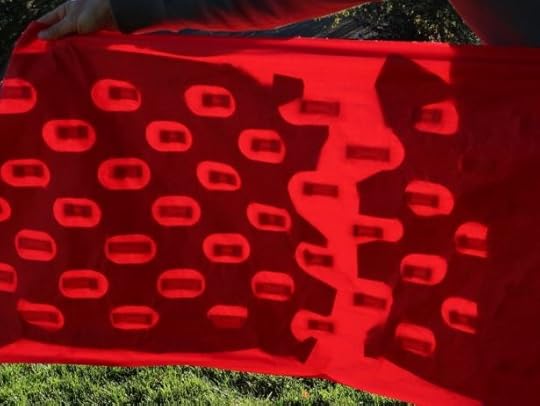
The Insulated AXL is widely reported to offer limited warmth. I speculate that there are two reasons: the use of a very lightweight/thin version of Primaloft Silver insulation (which is laminated to a Mylar sheet), and multiple holes in the insulation and Mylar that allow circulation within the pad of body-warmed and ground-cooled air.
Durability
My Insulated AXL has not yet sprung a leak. But I’m careful with it. YMMV.
A client managed to break the valve on one of my pads. I didn’t hear an explanation, but I bet it happened while rolling it up — if the valve flap is not in a “closed” position, it could get caught between the sheets and be torn off.
Thankfully, the damaged pad is still usable: I blow it up completely and cap it as quickly as I can. About 25 percent of the air is lost, but that’s still plenty — and, in fact, that level of inflation is just about perfect.
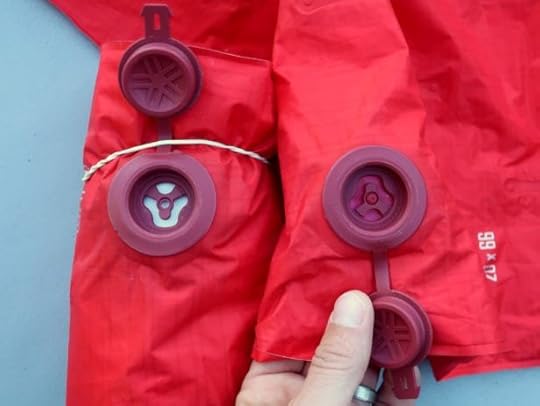
I did not get an explanation, but a client broke the valve on the left pad. Notice that the valve flap (it’s violet) is missing.
Inflation and deflation
It’s a chore to blow up the Insulated AXL, requiring about 20 strong exhales. That’s only a few breaths more than the XLite but it seems worse, because the valve allows for unrestricted inflation. The reducer on the XLite slows the process, helping to avoid light-headedness.
If you think backpacking is hard enough already, consider the Big Agnes PumpHouse Ultra ($35, 3 oz), which doubles as a stuff sack.
Deflation of the Insulated AXL is fast and easy: open the cap and press the valve flap. I do it while laying on the pad before I get up — the body weight helps to expel most of the air.
Buy now: Big Agnes Insulated AXL Sleeping Pad
Questions about the Insulated AXL, or have an experience to share? Please comment.
Disclosure. This website is supported mostly through affiliate marketing, whereby for referral traffic I receive a small commission from select vendors, at no cost to the reader. This post contains affiliate links. Thanks for your support.
The post Review: Big Agnes Insulated AXL Pad || Very light & comfy, not very warm appeared first on Andrew Skurka.



